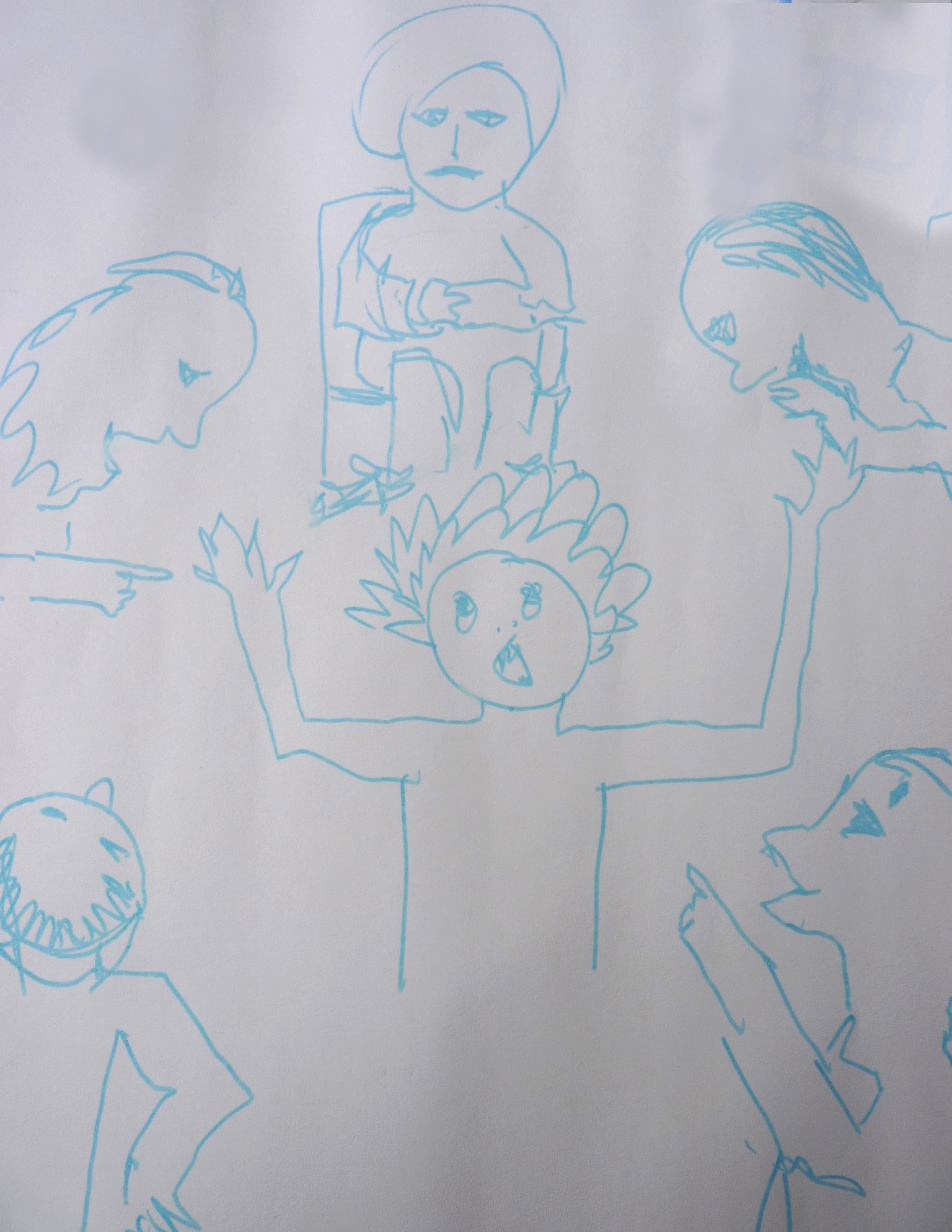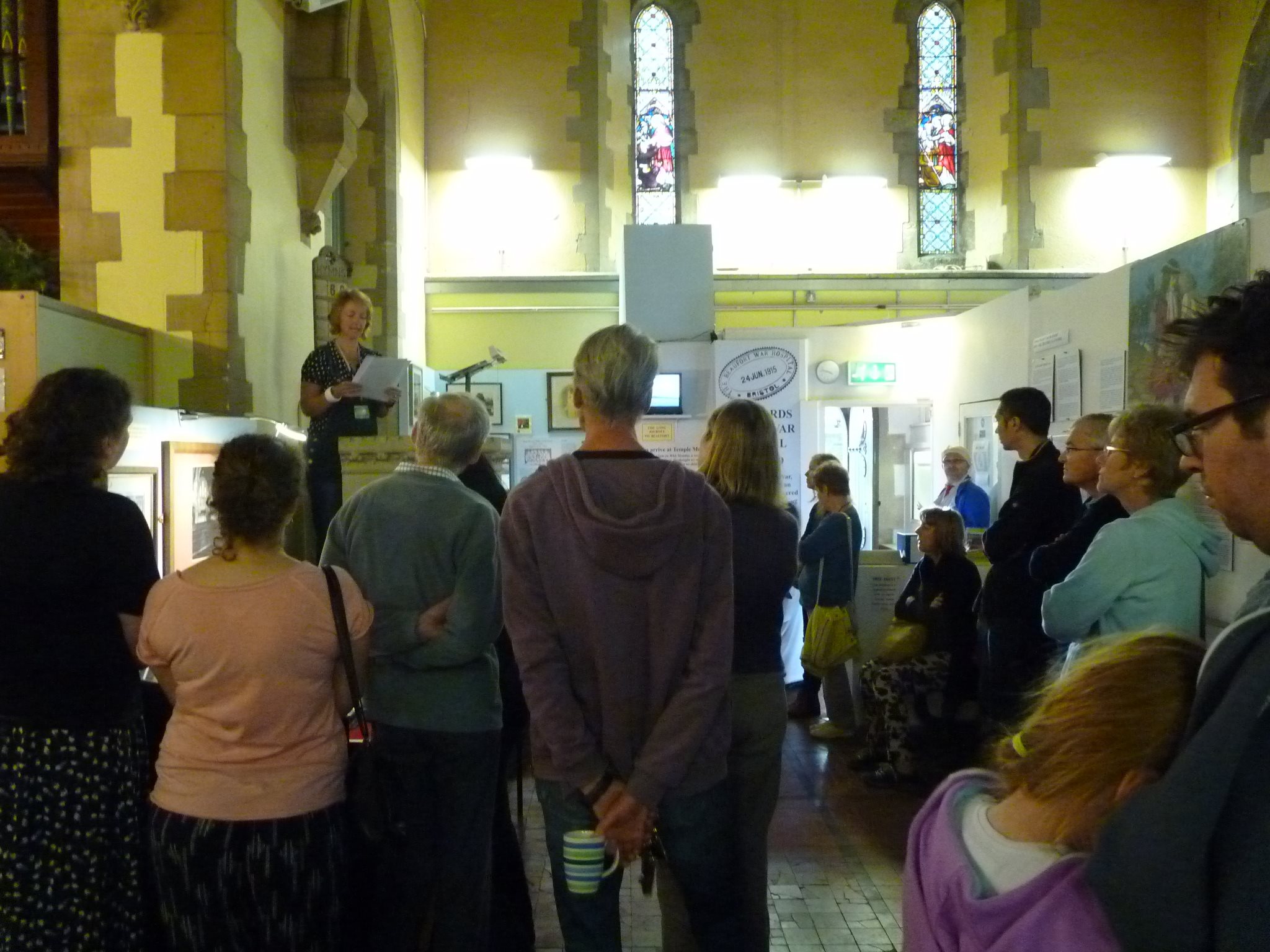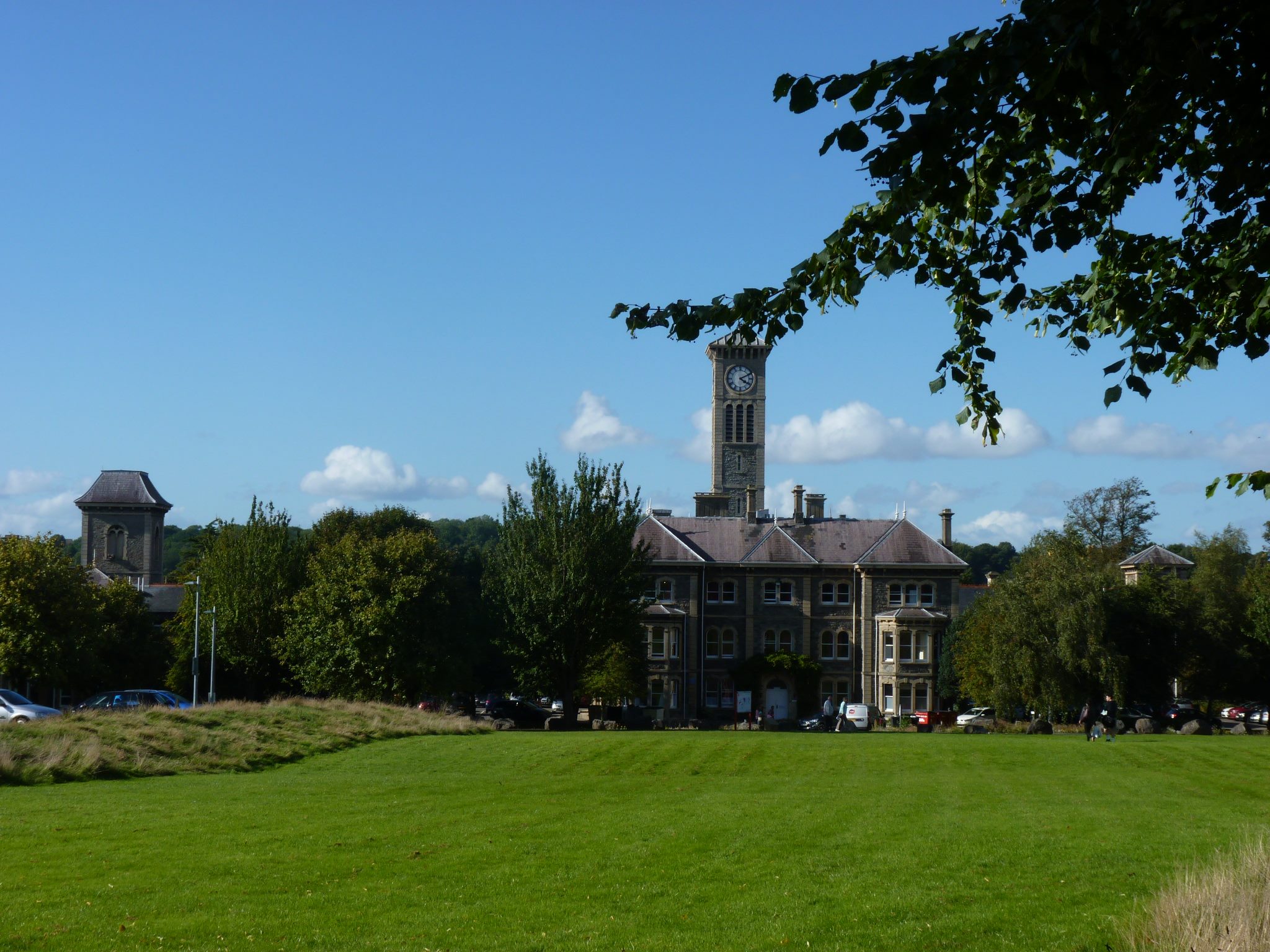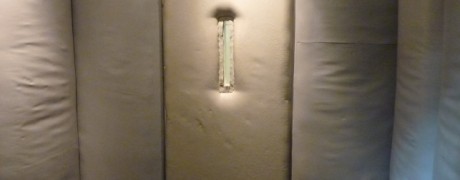Blog – by Lucy Bell, Glenside Hospital Museum
There are life-sized mannequins at Glenside Hospital Museum. Dressed in medical gowns, they treat other mannequins with everything from Epilepsy cures to Electro-Convulsive Therapy. I don’t know the provenance of these mannequins, but it adds to the appeal of this off-beat site that the psychiatric figures are striking fashion poses.
I was invited here to be a writer in residence for Bristol Doors Open day. The museum is in a church on the grounds of Bristol’s former asylum. The church was built for the psychiatric patients who once filed in through separate male and female doors on opposite sides of the nave. The virgin and child on the altar piece were apparently modelled on the asylum’s superintendent’s wife and daughter (make of that what you will).
The exhibits have none of the sterile qualities of modern museums and are utterly compelling. They exist to record and de-stigmatise mental illness and its treatment across a timeline starting in 1330, when “madness” is given a religious interpretation. The site also marks the history of Stokes Park Colony, a neighbouring facility founded to “find a cure” for learning disability but eventually used to provide residential care for learning disabled children and adults.
On the Doors Open Day, visitors’ reactions to the exhibits were personal, subjective and thoughtful:
“My father in law was a nurse here and my grandfather was deputy superintendent. That’s his photo there.”
“The first thing I noticed was the smell, that institutional smell”
“Says here: “1877 patients get clean underwear and socks every week.” That’s more often than I change my pants!”
“How would I describe irrational behaviour? When the situation doesn’t warrant the reaction, but who gets to decide that?”
“Hard to de-stigmatise mental illness when certain jobs are all about decision-making”
“My grandson is gay. According to their timeline, he might have been castrated”
“I worked in catering here. There was a lady who got admitted for falling pregnant as a teenager. She wandered the corridors an old lady. She’d forgotten why she came.”
There are weighted chairs with dovetailed joints (no nails, too heavy to be thrown), “guarded” forks with the gap between prongs filled in, a walk-in padded cell, lockable razors, a strait jacket, exquisite sketches by patients and photos of an Ice Age trepanned skull (amazing that early man knew personality was associated with the frontal lobes).
You can listen to vivid oral histories from nurses and patients, see haunting Victorian headshots of newcomers to the asylum, and read an unsettling timeline of lobotomy, the same procedure (carried out by butter knife or ice pick and often without general anaesthetic) which rendered JFK’s sister unable to care for herself for the rest of her life.
But the museum’s greatest resource is its volunteers, some of whom were psychiatric nurses at the mental health hospital throughout the fifties and sixties. They have a moving and tangible loyalty to the hundreds of patients who lived out their lives in the institution, eventually discharged through recovery or, more commonly death, and those among the consultants who really tried to improve things for them, however radical the methods appear.
“Understand that a padded cell was the final step in a long line of careful interventions to calm down and diffuse the patients’ feelings, and its use had to be signed off. Electro-Convulsive Therapy is still used today. Patients ask for it, and in those cases the outcomes are largely positive. You have to know how desperate those patients feel.”
An oft-cited statistic states one in four people experience mental ill health, from depression to eating disorders to psychosis, though over a life-time this figure is likely to be much higher. Suicide is still the primary cause of post-natal maternal death.
The fact remains that mental ill health, as much as physical illness, requires a strategy of treatment. What the lay person regards as ghoulish or macabre interventions, the volunteers see as the necessary origins of more subtly-calibrated approaches. It wasn’t till the mid 50’s that drugs were given to treat the illnesses themselves, rather than purely for sedation. Restraint is a dirty word in the 21st century, but at different times, people may need protection from themselves, and even desperately want restraint. Is a temporarily locked room worse than chemical restraint, which affects the long-term capacity to consent?
And it’s hard to exhibit an artefact that embodies the kindness and discretion of a good nurse, or the leaps forward made through Industrial Therapy (work placements for patients in remission) or Care in the Community (a controversial scheme which does, nonetheless, force professionals away from economies of scale to treat each patient as an individual).
I believe the exhibits of Glenside are emotionally beneficial to those visitors who care for learning-disabled relatives, or experience mental ill health. Seeing the history of care in one building helps to contextualise the frustrations of navigating medical and educational provision, and the divergent modern ideologies around disability.
Glenside Hospital Museum presented so much content for a writer to draw on, not least the vocabulary. There is “burn out” which described the mysterious disappearance of the original condition, usually, tragically, after the patient was incurably institutionalised. There was “on a card” when a patient is a risk to themselves and others, and needs to be “specialed” (checked-on every quarter of an hour). There is “doing the beds” (getting everyone up) and going “to the backs” where patients are washed. In fact the detail of old nursing guidelines on how to bath patients embodies the dilemmas around proper care:
“Under no circumstances are two patients to use the bath at the same time…patients are to be dried quickly with clean, unused towels…the keys to the taps are to be in the keeping of the nurse.”
Mental health provision, I realised, is a never-ending trade-off between hopeful medical intervention, safeguards for the patient’s dignity, and their safety. Viv, a psychiatric nurse from 1966-1994, was often uncomfortable with the economic factors behind the treatment of his patients (plus ca change…) But he stayed in the system to improve it from the inside. He believes we are lumbering closer to the right calibration of contradictory considerations.
“Has treatment of the mentally unwell improved?” he asks, “I think it has.
But then the world has improved.”
Performance Text – by Lucy Bell, Glenside Hospital Museum
(Click here to listen to a recording of the original performance)
BURDENS
My uncle Joe was in Stoke Park Colony, Fishponds. He went in there an Idiot and came out High-Grade Feeble Minded. Suppose you could say he got a promotion.
Yeah, no those were the legal medical definitions, in the fifties. Mentally Subnormal starts with Idiot at the bottom, then Imbecile, then Low Grade, Medium grade and High-Grade Feeble Minded. S’all in the patient inventory at Glenside Hospital Museum, that church full of exhibits they got up there now. Makes me smile, to know idiot was a medical word first. David Cameron’s PR team would fairly blow a gasket if they knew that, wouldn’t they? Him spouting off about this idiotic policy or other.
Some called Stoke Park the “Burdens Place”, on account of it being founded by the Reverend Burden and his wife. But me, stupid kid that I was, see, I thought that was the collective noun for learning disabled kids. “Burdens”.
“He was no burden to us!” my mum said. “Even if mealtimes was messy affairs.”
Joe used to sit in his chair and bounce forks off her head. Bits of spam fritter going East, West, North, South and everywhere in between, and the chair thumping on its front legs cause he loved his food. He had a special chair, Mum said, and when she was a little girl she called it Joe’s Messy Castle. Partly cause it was high, and it was messy, partly cause mealtimes, he was king and there absolutely bloody nothing you could do about it.
But Mum and Nan didn’t mind too much. Nan just tidied up ready for round two a few hours later. That was rare then, to keep him home. With the neighbours holding their kids back in case they caught it. But when Nan died, they couldn’t have him home no more. And it was an opportunity to get him out of the city and into them lovely green grounds. You know; Yew trees and Limes.
So Mum knew before all of us, what was happening with Harry. She was in a home by then, but I sat my grandson on her lap proud as punch and she just looked at him. Well that tore it. My daughter looked at us both then stormed out red in the face. She was sweating but they do keep that home hotter than the devil’s armpit.
“Ain’t he smiling yet?” Mum said.
“Maybe he don’t wanna smile”
“But he ain’t waving neither”
“He ain’t the Queen, what do you want?” I said.
Eight months later my daughter rings with the MRI results. Weird thing. She’s happy. I don’t mean like “resigned” happy. I mean Euro-Millions-Clooney’s-proposed-and-cake-don’t-make-you-fat-no-more happy.
“Did I hear you right?” I said, “Why you so chuffed about it?”
“Cause I’m not going mad, Mum,” she says. “I know what I’m dealing with.”
Harry’s five now and not talking. He signs instead. Funny. My grandson took six months to learn the sign for “bath” but got “cake” in three goes. And they called that mentally subnormal? There’s nothing different about his face, so people don’t notice till he squeaks and they all cover their ears and my daughter has to stop Bob, that’s my son in law, from lamping them. Bob’s in carers’ counselling now. Apparently men have a deep-seated evolutionary need to fix problems and he needs to work through that by doing more triathlons.
So while Bob was ironing his Lycra we went up Glenside Campus. I looked round the Museum while Harry and his mum ran rings round the Lime trees. They’ve got straitjackets and forks with the gaps between the prongs filled in. There’s ice age trepanated skulls in there and the whole sorry history of young men like Joe getting labotomised and damaged for life. Though Joe wasn’t, Thank God.
And before I knew it, well I was so embarrassed but I had tears streaming down my face; just thinking what Harry would have lived back then. A volunteer took me into a back room. She found Joe’s name in Stoke Park Patient’s Inventory and I said a little prayer over it. He died peaceful up there 1993. Then she showed me their mental health time line, for psychiatry and learning disability. 1407 Bedlam was opened, but would you credit it, it’s 1847 before patients are legally entitled to clean socks?
“Some of the exhibits in here look barbaric,” this lady said. “But they are the beginnings of people trying to help. It’s a long history of trial and error. But this place is the history of starting to get it right”




Comments are closed